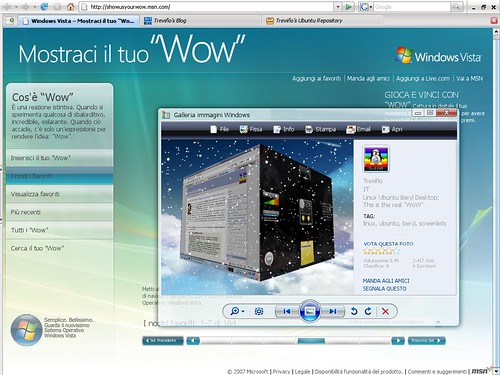Et me voila enfin sous beryl avec xgl 😀

c’est trop beau, trop fluide, trop puissant, trop personnalisable.

Evidemment, ça fais ronfler l’UC quand même mais bon j’ai quand même une vidéo 700×520 pixels sous flash qui tourne et une quinzaine d’onglet dans firefox le tout en 1650×1200. Et je n’ai pas de lenteur apparente.
Naturellement, avant d’arriver à ce résultat je ne vous cache pas que j’ai galèré… vu que ma carte graphique est une ATI, j’ai été obligé de passer par XGL laissant de coté AIGLX. Vous êtes obligé si vous possédez une carte ATI, AIGLX n’implémente pas les fonctions suffisantes mais dans le cas d’une carte nvidia il est conseillé.
Il vous d’habord installé XGL. Si vous avez des baisses de performance et que votre processeur mouline, c’est parce que la 3D n’est pas activé, donc il faut modifié votre xorg.conf. Personnellement, je n’es quasiment aucune différence de performance entre XGL seul et XGL + beryl, les deux sont fluides a souhait et je n’es pas la dernière de config supra pussante :
Dell Inspiron 9100
Pentium 4 HT 3 GHz – 768 Mo DDR
ATI Radeon Mobility 9800 256Mo
Je rappelle que c’est un portable.
Si ça peut vous aidez, voici mon xorg.conf :
# /etc/X11/xorg.conf (xorg X Window System server configuration file)
#
# This file was generated by dexconf, the Debian X Configuration tool, using
# values from the debconf database.
#
# Edit this file with caution, and see the /etc/X11/xorg.conf manual page.
# (Type "man /etc/X11/xorg.conf" at the shell prompt.)
#
# This file is automatically updated on xserver-xorg package upgrades *only*
# if it has not been modified since the last upgrade of the xserver-xorg
# package.
#
# If you have edited this file but would like it to be automatically updated
# again, run the following command:
# sudo dpkg-reconfigure -phigh xserver-xorg
Section "ServerLayout"
Identifier "Default Layout"
Screen "Default Screen" 0 0
InputDevice "Generic Keyboard"
InputDevice "Configured Mouse"
InputDevice "stylus" "SendCoreEvents"
InputDevice "cursor" "SendCoreEvents"
InputDevice "eraser" "SendCoreEvents"
InputDevice "Synaptics Touchpad"
EndSection
Section "Files"
# path to defoma fonts
FontPath "/usr/share/X11/fonts/misc"
FontPath "/usr/share/X11/fonts/cyrillic"
FontPath "/usr/share/X11/fonts/100dpi/:unscaled"
FontPath "/usr/share/X11/fonts/75dpi/:unscaled"
FontPath "/usr/share/X11/fonts/Type1"
FontPath "/usr/share/X11/fonts/100dpi"
FontPath "/usr/share/X11/fonts/75dpi"
FontPath "/usr/share/fonts/X11/misc"
FontPath "/var/lib/defoma/x-ttcidfont-conf.d/dirs/TrueType"
EndSection
Section "Module"
Load "i2c"
Load "bitmap"
Load "ddc"
Load "dri"
Load "extmod"
#SubSection "extmod"
# Option "omit xfree86-dga"
#EndSubSection
Load "freetype"
Load "glx"
Load "int10"
Load "type1"
Load "vbe"
EndSection
Section "InputDevice"
Identifier "Generic Keyboard"
Driver "kbd"
Option "CoreKeyboard"
Option "XkbRules" "xorg"
Option "XkbModel" "pc105"
Option "XkbLayout" "fr"
Option "XkbVariant" "nodeadkeys"
Option "XkbOptions" "lv3:ralt_switch"
EndSection
Section "InputDevice"
Identifier "Configured Mouse"
Driver "mouse"
Option "CorePointer"
Option "Device" "/dev/input/mice"
Option "Protocol" "ExplorerPS/2"
Option "ZAxisMapping" "4 5"
Option "Emulate3Buttons" "true"
EndSection
Section "InputDevice"
Identifier "Synaptics Touchpad"
Driver "synaptics"
Option "SendCoreEvents" "true"
Option "Device" "/dev/psaux"
Option "Protocol" "auto-dev"
Option "HorizScrollDelta" "0"
EndSection
Section "InputDevice"
# /dev/input/event
# for USB
Identifier "stylus"
Driver "wacom"
Option "Device" "/dev/wacom" # Change to
Option "Type" "stylus"
Option "ForceDevice" "ISDV4" # Tablet PC ONLY
EndSection
Section "InputDevice"
# /dev/input/event
# for USB
Identifier "eraser"
Driver "wacom"
Option "Device" "/dev/wacom" # Change to
Option "Type" "eraser"
Option "ForceDevice" "ISDV4" # Tablet PC ONLY
EndSection
Section "InputDevice"
# /dev/input/event
# for USB
Identifier "cursor"
Driver "wacom"
Option "Device" "/dev/wacom" # Change to
Option "Type" "cursor"
Option "ForceDevice" "ISDV4" # Tablet PC ONLY
EndSection
Section "Monitor"
Identifier "Generic Monitor"
Option "DPMS"
EndSection
Section "Device"
Identifier "ATI Technologies, Inc. M18 JN [Radeon Mobility 9800]"
Driver "fglrx"
Option "VideoOverlay" "on"
Option "OpenGLOverlay" "on"
BusID "PCI:1:0:0"
EndSection
Section "Screen"
Identifier "Default Screen"
Device "ATI Technologies, Inc. M18 JN [Radeon Mobility 9800]"
Monitor "Generic Monitor"
DefaultDepth 24
SubSection "Display"
Depth 1
Modes "1920x1200"
EndSubSection
SubSection "Display"
Depth 4
Modes "1920x1200"
EndSubSection
SubSection "Display"
Depth 8
Modes "1920x1200"
EndSubSection
SubSection "Display"
Depth 15
Modes "1920x1200"
EndSubSection
SubSection "Display"
Depth 16
Modes "1920x1200"
EndSubSection
SubSection "Display"
Depth 24
Modes "1920x1200"
EndSubSection
EndSection
Section "DRI"
Mode 0666
EndSection
Section "Extensions"
Option "Composite" "disable"
EndSection
Section "ServerFlags"
Option "AIGLX" "off"
EndSection
Si vous vous retrouver avec un écran blanc, mais que le cube est quand même fonctionnel (ce sont les bureau qui sont blanc en fait), c’est à cause de la dernière versions de beryl qui semble ne pas fonctionné correctement. Il faut donc remettre l’ancienne version :
on désinstalle les paquets :
sudo apt-get remove 'beryl*'
et on réinstalle avec les anciens paquets :
sudo apt-get install beryl=0.1.99.2~0beryl1 beryl-core=0.1.99.2~0beryl1 beryl-manager=0.1.99.2~0beryl1 beryl-plugins=0.1.99.2~0beryl1 beryl-plugins-data=0.1.99.2~0beryl1 beryl-settings=0.1.99.2~0beryl1 beryl-settings-bindings=0.1.99.2~0beryl1 emerald=0.1.99.2~0beryl1 libberyldecoration0=0.1.99.2~0beryl1 libberylsettings0=0.1.99.2~0beryl1 libemeraldengine0=0.1.99.2~0beryl1 emerald-themes=0.1.99.2~0beryl1 -V
un petit CTRL+ALT+BACKSPACE et le tour est joué. Faites attention à ne pas remettre à jour beryl lorsque Synaptic vous le demande, attendez une version plus stable. Je ne manquerais pas de poster lorsqu’elle sortira.
Voila, maintenan on est bien loin de Vista et de ses maigres éffets qui de plus sont inutiles. Il n’y a même pas de multi-bureau !!!
En plus, j’ai pu installé les derniers drivers ati, ce que je ne peut même pas faire sous Windows XP car les drivers officiels ne reconnaissent pas ma carte. C’est Dell qui doit normalement me fournir la nouvelle versions recompilé à leur sauce. Mais j’attend toujours une réponse du support… Rappelons que ses nouveaux drivers sont optimisés même pour les anciennes cartes graphiques car ils prennent en charge des fonctionnalités multi-thread très utile lorsque l’on dispose de plusieurs core processeurs (physique ou virtuel : HT).
Bon je vais allez impressionner ceux qui font les beau avec windobe 😛
++






